Fairchild C-123 Provider Video - Picture
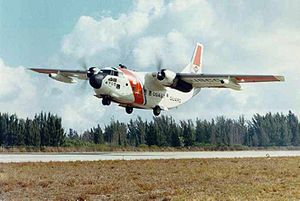
|
|
Fairchild C-123 Provider
C-123 Provider

Picture - A United States Coast Guard HC-123B Provider from CGAS Miami.
Role: Military transport aircraft
Manufacturer: Chase Aircraft
Fairchild Aircraft
Designed by: Michael Stroukoff
First flight: 14 October 1949
Primary users: United States Air Force
United States Coast Guard
South Vietnamese Air Force
Developed from: Chase XCG-20
Variants: Chase XC-123A
Stroukoff YC-134
The C-123 Provider was an American military transport aircraft designed by Chase Aircraft and subsequently built by Fairchild Aircraft for the United States Air Force. In addition to its USAF service, which included later service with the Air Force Reserve and Air National Guard, it also went on to serve most notably with the United States Coast Guard and various air forces in South East Asia. During the Vietnam War, the aircraft was used to spray Agent Orange.
Design and development
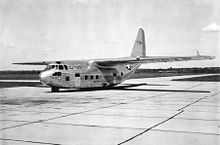
Picture - A Chase XG-20 glider, which was later converted to the XC-123A prototype.
The C-123 Provider was designed originally as an assault glider aircraft for the United States Air Force (USAF) by Chase Aircraft as the XCG-20 (Chase designation MS-8 Avitruc) Two powered variants of the XCG-20 were developed during the early 1950s, as the XC-123 and XC-123A. The only difference between the two was the type of engines used. The XC-123 used two Pratt & Whitney R-2800-23 air-cooled radial piston engines, while the XC-123A was fitted with four General Electric J47-GE-11 turbojets, in two pods. The XC-123A also has the distinction, while only experimental, of being the USAF first jet powered military transport. While the piston powered XC-123 was initially well regarded for tactical transport for its ruggedness and reliability and ability to operate from short and unimproved airstrips, the turbojet powered XC-123A - designed for high-speed transport between USAF bases for critical parts and personnel - was found unable to operate from short and rough airstrips. There was also no practical speed advantage due to the wing and fuselage design, and a drastic reduction in range. Only the one turbojet-powered test and evaluation version was built.
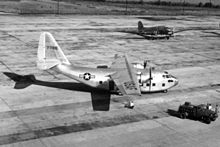
Picture - The XC-123 prototype.
By 1953, Henry J. Kaiser purchased a majority share in Chase Aircraft, feeling that after having completed C-119s for Fairchild under contract, he could take control of the impending C-123 contract. Two airframes were completed at Kaiser's Willow Run factory in Ypsilanti, Michigan, before personal politics led to Kaiser's being told that no further contracts with him would be honored. The C-123 contract was put up for bid, and the two completed airframes scrapped. The contract was finally awarded to Fairchild Engine and Airplane, who assumed production of the former Chase C-123B, a refined version of the XC-123. Before turning production over to Fairchild, Chase originally named their C-123B the AVITRUC but it never stuck.
Operational history
The first recipients of C-123 aircraft would be USAF transport units, soon followed by the United States Coast Guard (USCG) who used the aircraft for search and rescue missions, and even the US Air Force Demonstration Team, the "Thunderbirds," would use C-123s for a time. The type would also be widely exported under various US military assistance programs, directly from USAF stocks.
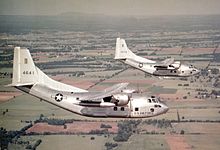
Picture - USAF C-123Bs in the 1950s.
The aircraft was nearly ignored by the USAF for service in Vietnam, but a political rivalry with the US Army and the Army's use of the CV-2 Caribou and later pre-production order for the C-8 Buffalo, led to a decision to deploy C-123s there. To compete with the well-performing CV-2, the USAF and Fairchild furthered development on the C-123 to allow it to do similar work on short runways. This additional development increased the utility of the aircraft and its variants to allow it to perform a number of unique tasks, including the HC-123B which operated with the USCG fitted with additional radar equipment for search and rescue missions through 1971, and the C-123J which were fitted with retractable skis for operations in Greenland and Alaska on compacted snow runways.
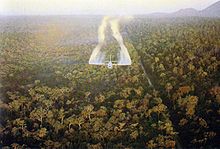
Picture - A Ranch Hand UC-123B over Vietnam in 1962.
By 1962, the C-123K variant aircraft was evaluated for operations in Southeast Asia and their stellar performance led the Air Force to upgrade 180 of the C-123B aircraft to the new C-123K standard, which featured auxiliary jet pods underneath the wings, and anti-skid brakes. In 1968, the aircraft helped resupply troops in Khe Sanh, Vietnam during a three-month siege by North Vietnam.
A number of C-123s were configured as VIP transports, including General William Westmoreland's White Whale. The C-123 also gained notoriety for its use in "Operation Ranch Hand" defoliation operations in Vietnam. Oddly enough, the USAF had officially chosen not to procure the VC-123C VIP transport, opting instead for the Convair VC-131D.
The first C-123s to reach South Vietnam were part of the USAF's Special Aerial Spray Flight, as part of Operation Ranch Hand tasked with defoliating the jungle in order to deny rebels their traditional hiding places. These aircraft began their operations at the end of 1961. Aircraft fitted with spraying equipment were given the U prefix as a role modifier, with the most common types being the UC-123B and the UC-123K. Aircraft configured for this use were the last to see military service, in the control of outbreaks of insect-borne disease. The C-123 was also used as "jump aircraft" for U.S. Army Airborne students located at Lawson Army Airfield, Fort Benning, Georgia in the late 1970s and early 1980s. This aircraft was used in conjunction with the Lockheed C-130 Hercules and Lockheed C-141 Starlifter.
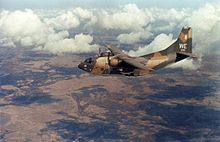
Picture - A 19th ACS C-123K over the Mekong Delta, 1969.
With the end of the Vietnam War, remaining C-123Ks and UC-123Ks were transferred to Air Force Reserve (AFRES) and the Air National Guard (ANG) that were operationally-gained by Tactical Air Command (TAC) prior to 1975 and Military Airlift Command (MAC) after 1975.
The 302nd Tactical Airlift Wing at Rickenbacker AFB (later Rickenbacker ANGB), Ohio flew the last UC-123Ks Providers in operational service before converting to the C-130 Hercules. Known as the Special Spray Flight, these aircraft were used to control insect-borne diseases, with missions to Alaska, South America and Guam being among the humanitarian duties performed by this Air Force Reserve unit.
The final examples of the C-123 in active US military service were retired from the Air Force Reserve and Air National Guard in the early 1980s. Some airframes were transferred to the Federal Aviation Administration (FAA) for test and evaluation programs while others were transferred to the US Department of Agriculture (USDA) for miscellaneous programs. These aircraft were also retired by the end of the 1990s.
Experimental projects
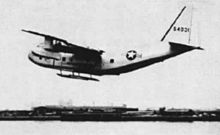
Picture - YC-123E with pantobase landing gear
In 1954, the YC-123D, formerly the XC-123A prototype, flew in its modified state after being converted by Stroukoff Aircraft. While the most obvious change from the original XC-123A was the switch of engines, the YC-123D also had a Boundary layer control (BLC) system fitted. This system directs air from the engines at high speed over the top of the wing, making the wing act as if the aircraft is flying at a much higher airspeed. As a result, the YC-123D had a greatly reduced take-off and landing distance. Compared to the C-123B, the YC-123D could land in 755 feet instead of 1,200, and take-off with only 850 ft of runway instead of 1,950, with a 50,000 lb total weight.
In 1955, Stroukoff, under contract from the USAF, produced a single YC-123E, designed to be able to take off from any surface, and also equipped with BLC. The new aircraft also featured Stroukoff's Pantobase system, combining a ski system with a sealed fuselage and wing mounted floats, while retaining its normal landing gear. The skis worked both on snow and water, and the system effectively allowed the aircraft to land on water, land, snow or ice.
In 1956, the USAF awarded a contract to Fairchild to design an improved version of the C-123 under the designation C-136, but the contract was cancelled before the aircraft was built.
At much the same time the YC-123H was under development, the product of a Fairchild modification program started in 1956 and completed in 1957. A "Jet Augmentation Program" for existing C-123Bs had been initiated in 1955 at the behest of the USAF, and in the YC-123H contract the USAF expanded it to allow the mounting of two pod-mounted General Electric CJ-610 (later developed as the military J85) turbojets. Perhaps more impressive was the new wide-track main landing gear, noticeable since the larger gear and tires required the removal of the landing gear doors. The new gear reduced the aircraft's turning radius and improved the Maximum Take Off Weight (MTOW) of the aircraft, along with being rugged enough to stand up to unimproved runways, all important factors for the C-123's mission profile. Testing both in the United States and in South Vietnam continued until the YC-123H crashed in an accident in 1963. However, many of the design improvements were carried over to the C-123K.
In 1979, the Royal Thai government, seeking to extend the life of their C-123 fleet, placed a contract with the Mancro Aircraft Company, supported by the USAF, to convert a single C-123B to turboprop powerplants. Allison T56-A-7 turboprops were used and by the time the aircraft, dubbed C-123T, was complete it had new "wet" wings, an Auxiliary Power Unit (APU) to assist with power movement of the control surfaces, and a heating system for the cargo compartments that also fed a new deicing system. Budgetary restrictions forced the Thai government to abandon the program in 1981, and with a lack of interested parties development of the C-123T stopped. However, it concluded the life of the C-123 by making it the only aircraft (at least this is claimed) to operate under jet, internal combustion and turboprop engine power, and as a glider, during its history.
The C-123T has recently been revived by a joint venture between the US-based Fleetwings Aircraft Company and the South African company Elmer Group. In 2010 they announced a project to initially remanufacture old airframes for African customers and, where there was demand, to build new aircraft. The airframes would be fitted with new turboprop Rolls-Royce T56-A-15 engines, a âglassâ cockpit and other enhancements. The proposed C-123T would have had a 25,000 lb payload capability, and a take-off run of just over 1,000 ft at 50,000 lb MTOW. Possible applications included maritime patrol, search and rescue, and even use as a gunship, while roll-on packages have already been developed for mid-air refuelling and agricultural applications.
Black Spot and other special military C-123s
During the Vietnam War, a number of C-123s were modified for specialized roles. Most of these modifications were on a one- or two-aircraft level. Only the usage of C-123s as "flare ships" to illuminate targets for fixed wing gunships such as the AC-47 and AC-119G were more numerous. These aircraft, operating under the call-sign Candle were flown by the USAF's 14th Special Operations Wing.
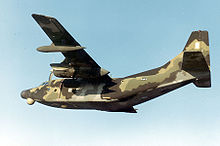
Picture - USAF NC-123K "permanent test" model used over the Ho Chi Minh Trail. It was outfitted with FLIR, LLLTV, laser rangefinder, and cluster bomb dispensers.
A single C-123B was tested as a possible replacement for the Candle aircraft, with its rear loading ramp removed and replaced with a large box with 28 large lights. The airplane could continuously light a 2-mile circle from an altitude of 12,000 feet. This aircraft, under the provisional designation NC-123B was dropped because the lights, fixed to the aircraft, made it far easier for enemy gunners to track compared to the earlier flare ships.
The "Candle" aircraft had an extended life when several UC-123K's were transferred to Nakhon Phanom Royal Thai Air Force Base in Thailand. During that period, it was used as a flare ship as well as a forward air control (FAC) aircraft. The flare duties were generally used for troops in contact (TIC) while the FAC mission directed air strikes in Laos over the Ho Chi Minh trail.
Another NC-123B was used as a radio relay aircraft over the Ho Chi Minh trail, with equipment to read the signals from various sensors on the ground designed to pick up enemy truck activity.
Two C-123K aircraft modified in September 1965 under Project Black Spot. The Black Spot aircraft were to fit under the "self-contained night attack capability" that was Operation Shed Light's primary focus and E-Systems of Greenville, Texas was contracted to complete the modifications. These aircraft featured a variety of new sensors including Low Light Level TV (LLLTV), Forward Looking Infrared (FLIR), and a laser rangefinder. The aircraft looked radically different visibly from its transport brethren, as the new equipment required lengthening the nose by over 50 inches. The aircraft also featured an armament system designed to carry BLU-3/B (using the ADU-253/B adapter) or BLU-26/B (using the ADU-272/B adapter) bomblets, or CBU-68/Bs cluster bombs.
The two aircraft, AF Serial Numbers 54-0691 and 54-0698, were first designated NC-123K in 1968 and then redesignated AC-123K in 1969. These NC/AC-123Ks were first deployed operationally at Osan AB, South Korea between August and October 1968, and flying in support of operations against North Korean infiltrators approaching by boat. The operations in Korea met with a certain level of success and as a result the NC/AC-123Ks were transferred to South Vietnam in November 1968. The aircraft operated there until January 1969, when they were redeployed to Ubon RTAB, Thailand. The two aircraft were then returned to the United States to Hurlburt Field, Florida in May 1969, where a second round of training occurred. Four crews attended a ground school in Greenville, Texas and returned to Hurlburt where they flew the aircraft for the first time.
The fate of the aircraft is still unclear. Sources have missions terminating in early July 1970 and the aircraft flying to the Military Aircraft Storage and Disposition Center (MASDC) "boneyard" at Davis-Monthan AFB, AZ, where they were returned to C-123K standard, then returned to South Vietnam still wearing their camouflage and black undersides for transport duty. However, the official history states that combat operations ceased on 11 May 1969, with no mention of the second deployment. While the second deployment is mentioned in associated documentation, the only dates are of the arrival in Thailand and there is no information as to when they departed or where their destination was.
Covert Operations
In 1962, the CIA acquired 5 C-123Bs from USAF for Air America to be used in Loas and Vietnam, and another 5 C-123Bs to be used by ROCAF/Taiwan's top secret 34th Squadron, a Black Ops units called the "Black Bat", as Flight B section(Flight A section is the 2 P2V-2U/RB-69A). The 5 Taiwan C-123Bs were sent to Lockheed Skunk Works for modifications as covert insertion aircraft with 'smart' air to air jammer, BSTR system to jam the radars of ground anti-aircraft guns, also added a defensive operator's station to operate the jammers on board, with extra fuel in underwing tanks, with 36 Taiwanese crew finished training courses at Pope AFB by November 1962. The 5 ROCAF/Taiwan/CIA C-123Bs would be used over North Vietnam as low level and nighttime covert airdrop aircraft, under the South Star II agreement, under the guise of Taiwan's national airline, China Airline, which had "cover story" of operating Vietnamese Air Transport(VIAT) in South Vietnam, that was formerly operated by Air America. The secret outfit was based in Saigon, but would fly out of Da Nang for airdrop missions going into North Vietnam, with some were 14 hours long missions.
On 1 February 1964, the overall control of South Star II was transferred from CIA to Studies and Observations Group(SOG), as part of US Military Assistance Command Vietnam(MACV) in Saigon. The outfit was redesignated as Det. 1 of USAF's 75th Troop Carrier Squadron(TCS), but within SOG was know as the First Flight Detachment(FFD).
In May 1964, under Project Duck Hook, 6 more C-123s were obtained for the secret Taiwanese Black Bat outfit operating in South Vietnam, with heavy modifications done by Lockheed Air Service at Ontario, CA, with ATIR and BSTR ECM package, ASN-25 Doppler navigation system, APN-153 terrain-following radar, a console station for radio operator, new HF radio and other radios. IN October, MACV, CIA and ROCAF/Taiwan signed the South Star III agreement to continue the operation in Vietnam. The 6 Duck Hook C-123Bs were based in Nha Trang, north of Cam Ranh Bay, officially designated as USAF Det. 12 of 1131 Special Activities Squadron. The Duck Hook C-123Bs were updated with RDR-10 weather radar and ARN-131 homing receiver in 1966 in order to perform missions over Ho Chi Minh trail. All C-123Bs were converted to C-123Ks in 1968, with 2 wing-mounte turbjets, plus ECM upgrade with APR-25 radar warning receiver and ALE-1 chaff dispenser. Project Duck Hook designation was changed to Heavy Hook. The unit at Nha Trang as Det. 12 of 1131 Special Activities Squadron received an outstanding unit award from USAF, for flow 4,000 classified combat and combat support missions from June 1966 to May 1968.
In May 1970s, Black Bats' C-123Ks supported the secret US military incursion into Cambodia. In October 1970, flights into Laos began. March 1972, the SOG was deactivated, and the Southern Star operation ended with 4 surviving C-123Ks returned to Taiwan. And on 1 March 1973, 34th "Black Bat" Squadron of ROCAF/Taiwan was disbanded.
C-123B/K aircraft used by the 34th "Black Bat" Squadron of ROCAF/Taiwan, from 1962 to 1973:
54-0641 crashed 27 June or 31 August, 1965. (Either shot down by Vietcong with 20mm cannon retrieved from a crashed A-1 with 12 Taiwanese air crew and 2 Americans from SOG were killed, or crashed during ferry flight back to Taiwan, with all 9 aircrew were killed.)
54-0643
54-0657 (crashed 22 August, 1967, ditched over South China Sea when developed engine trouble, 5 aircrew were drowned.)
54-0704
54-0715 (crashed 10 May, 1967, near Hsinchu, while conducting single engine approaches training missions. 2 flight engineers were killed; the pilots were hurt.)
55-4522 (crashed 24 December, 1964, Monkey Mountain near Da Nang, South Vietnam on a nighttime training drop mission. All aircrew were killed.)
55-4528
55-4543
55-4551 (crashed 10 May, 1963, Pingtung Dahu Mountain in Southern Taiwan on a training mission. All 12 aircrew were killed.)
56-4355
56-4356 crashed 27 June or 31 August, 1965. (Either shot down by Vietcong with 20mm cannon retrieved from a crashed A-1 with 12 Taiwanese air crew and 2 Americans from SOG were killed, or crashed during ferry flight back to Taiwan, with all 9 aircrew were killed.)
56-4528
Variants
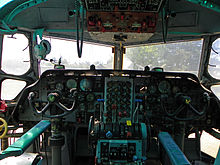
Picture - Cockpit of a C-123K Provider at the Castle Air Museum
Chase XCG-20
Two prototype all-metal troop transport gliders built by Chase Aircraft, later designated the XG-20, one became the XC-123, the other the XC-123A.
Chase XC-123
Former XG-20 fitted with two 2,200 hp R-2800-23 engines.
Chase XC-123A
Former XG-20 fited with four J47-GE-11 turbojets in pairs (of the type used by the B-36 and B-47) under wings.
C-123B
Production model based on the XC-123 with two 2300 hp R-2800-99W engines with accommodation for 61 troops or 50 stretchers, five built by Chase and 302 build by Fairchild Aircraft.
UC-123B
C-123Bs modified for defoliation and crop destruction duties.
VC-123C
Executive transport version of the jet-powered XC-123A, not built.
Stroukoff YC-123D
One aircraft built by Stroukoff with boundary layer control system for improved VTOL performance.
Stroukoff YC-123E
One aircraft built by Stroukoff with modified fin and rudder, modified fuselage bottom (called Pantobase) and pontoon floats to allow operation from water, sand, snow or ice.
YC-123H
Prototype with wide track undercarriage and two underwing J85 booster engines.
C-123J
C-132B with two wing tip mounted Fairchild J44-R-3 booster engines, 10 converted.
C-123K
C-123Bs with two underwing J85 booster engines and larger wheels, 183 converted.
AC-123K/NC-123K
Two C-132Bs converted for armed nighttime surveillance with special sensors.
C-123T
Proposed upgrade for Royal Thai Air Force C-123Bs including installation of turboprop engines; cancelled due to budgetary reasons.
HC-123B
USCG search and rescue variant
UC-123K
C-123Ks converted for Ranch Hand defoliation missions, 34 converted.
VC-123K
One C-123K converted as personal transport for General Westmoreland's use in Vietnam.
Stroukoff YC-134
One aircraft built by Stroukoff, as C-123B but fitted with boundary layer control system, tailplane endplates, redesigned landing gear with tandem mainwheels. Later designated YC-134A when fitted with Pantobase landing gear.
YC-136
Proposed improved variant; cancelled before any aircraft built.
Operators
Brazil
Brazilian Air Force - two resold to VARIG
Cambodia
Royal Cambodian Air Force
Republic of China (Taiwan)
Republic of China Air Force
34th "Black Bat" Squadron, 1962 to 1973
34th "Black Bat" Squadron, 1962 to 1973
El Salvador
Air Force of El Salvador
Laos
Lao People's Liberation Army Air Force
Philippines
Philippine Air Force
Saudi Arabia
Royal Saudi Air Force
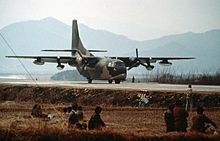
Picture - A South Korean C-123K in 1989.
South Korea
Republic of Korea Air Force
South Vietnam
South Vietnamese Air Force
Thailand
Royal Thai Air Force
United States
US Air Force
US Coast Guard
Venezuela
Venezuelan Air Force
Specifications (C-123K Provider)
General characteristics
Crew: 4
Capacity: 62 passengers, 50 litters or 24,000 pounds (11,000 kg) of cargo
Length: 76.25 ft (23.92 m)
Wingspan: 110 ft (33.53 m)
Height: 34 ft (10.36 m)
Wing area: 1,223 ft² (113.6 m²)
Empty weight: 35,366 lb (16,042 kg)
Max takeoff weight: 60,000 lb (27,000 kg)
Powerplant:
2x General Electric J85-GE-17 turbojets, 2,850 lbf (13 kN) each
2x Pratt & Whitney R-2800-99W "Double Wasp" 18-cylinder radial engines, 2,300 hp (1,715 kW) each
Performance
Maximum speed: 228 mph (198 knots, 367 km/h) with jets
Range: 1,035 mi (899 nm, 1,666 km) combat
Service ceiling: 29,000 ft (8,800 m)
Rate of climb: 1,150 ft/min (5.8 m/s) without jets
Wing loading: 49 lb/ft² (240 kg/m²)
Power/mass (prop): 0.077 hp/lb (130 W/kg)
Thrust/weight (jet): 0.10
Accidents and incidents
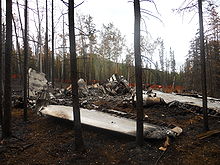
Picture - Crash site of the C-123 from Con Air, Mount Healy, Denali National Park, Alaska
10 October 1958: A C-123B Provider, 55-4521, en route from Hill AFB, Utah to McChord AFB, Washington, with five USAF Thunderbirds flight crew and 14 maintenance personnel, flew through a flock of birds and crashed into a hillside six miles east of Payette, Idaho, just before 1830, killing all on board. This accident remains the worst loss-of-life in Thunderbirds team history.
11 December 1965: En route to Tuy Hoa Air Base, a USAF C-123 hit some trees on top of a ridge, causing it to enter a spin and crash. All four crew and 81 passengers were killed.
6 February 1982: A South Korean Air Force C-123 crashed into a volcano while on approach to Jeju International Airport, killing all 53 people on board.
1 August 2010: The aircraft used for flying scenes in the movie Con Air, C-123K #54-0709, registration N709RR (cn: 20158), crashed in Denali National Park while performing a cargo flight for All West Freight. All three crew members perished.
Survivors
Picture - A C-123K on display at Air Mobility Command Museum at Dover AFB.
Museum examples of C-123s include those located at:
Air America Foundation, Inc.(Owner) (housed at) Valiant Air Command Warbird Museum, Space Coast Regional Airport, Titusville, Florida
Air Heritage Museum in Beaver Falls, Pennsylvania; this museum's C-123K, "ThunderPig," is operational and available for air shows
Benito Ebuen AFB, Mactan Island, Philippines, PAF
Castle Airport, California, Castle Air Museum, C-123K #55-4512 (on loan from NMUSAF)
Dover AFB, Delaware, Air Mobility Command Museum, C-123K #54-0658 (on loan from NMUSAF)
Dyess AFB, Texas, C-123K #54-0604 (on loan from NMUSAF)
El Avion restaurant in Hotel Costa Verde, Costa Rica has the twin of the CIA-operated aircraft downed by the Sandinista forces over Nicaragua in 1986. The aircraft has been converted into a bar.
Fort Bragg, North Carolina, 82nd Airborne Division War Memorial Museum, C-123K #54-0609 (on loan from NMUSAF)
Hill Aerospace Museum, Hill AFB, Utah, C-123K #54-0610 (on loan from NMUSAF)
Hurlburt Field, Florida, Hurlburt Field Memorial Air Park, C-123K #55-4533 (on loan from NMUSAF)
Jesada Technik Museum, Thailand, C-123K #54-0576 (aircraft used in Operation Dumbo Drop)
Jinpo maritime Theme park, Gunsan, South Korea
Kulis ANGB, Anchorage, Arkansas, C-123J #56-4395 (on loan from NMUSAF)
Lackland AFB, Texas, C-123K #54-0668 (on loan from NMUSAF)
Little Rock AFB, Arizona, Air Park, C-123K #55-4567 (on loan from NMUSAF)
March ARB, California, March Field Air Museum, C-123K #54-0612 (on loan from NMUSAF)
Pima Air and Space Museum (adjacent to Davis-Monthan AFB), Tucson, Arizona, C-123B #55-4505 (on loan from NMUSAF)
Muan International Airport, South Korea
Museum of Alaska Transport and Industry, Wasilla Airport, Alaska
Museo de la Aviacix³n, Ilopango Airport, Ilopango, El Salvador, FAS
Pope AFB, North Carolina, Air Park, C-123K #54-0669 (painted as #54-0372) (on loan from NMUSAF)
Robins AFB, Georgia, Museum of Aviation, C-123B #54-0633 (on loan from NMUSAF)
Royal Thai Air Force Museum, Don Muang AFB
Travis AFB, California, Travis Air Museum, C-123K #55-4507 (on loan from NMUSAF)
War Memorial of Korea, Seoul, South Korea
Wright-Patterson AFB, Ohio, National Museum of the United States Air Force, C-123K #56-4362
Several other examples of C-123s remain in an active flying status, operated by private owners in the United States or by various air forces worldwide. Many C-123K owned by the USAF Museum have had their J85-17A engines removed for use in the BQM-34A Firebee drone program.
Notable appearances in media
A C-123 was prominently featured in the action film Con Air, as well as Operation Dumbo Drop and Air America.
Related development
Chase XCG-20
Chase XC-123A
Stroukoff YC-134
Comparable aircraft
Alenia G.222
Citations
Bibliography
Andrade, John. U.S. Military Aircraft Designations and Serials since 1909. Leichester, UK: Midland Counties Publications, 1979, ISBN 0-904597-22-9.
Boerschig Jr, Charles A. Black Spot Special Activities Report. Ubon, Thailand: Black Spot Task Force, 1969.
Davis, Larry. Gunships: A Pictorial History of Spooky. Carrollton, Texas: Squadron/Signal Publications, 1982.
Green, William and Gerald Pollinger. The Aircraft of the World. London: Macdonald, 1955.
Gunston, Bill. The Encyclopedia of the World Air Power. New York: Crescent Books, 1980. ISBN 0-517-53754-0.
Gunston, Bill, ed. The Illustrated Encyclopedia of Commercial Aircraft. New York: Exeter Books, 1980. ISBN 978-0896730779.
Halliday, Tony T. Flying Through Midnight. London: New Scribner/Lisa Drew Book, 2007. ISBN 978-0743274883.
The Illustrated Encyclopedia of the World's Modern Military Aircraft. London: Salamander Books, 1977. ISBN 0-86101-010-8.
Smith, C.M. History of the Black Spot Task Force, 29 July 1968-11 May 1969. Eglin Air Force Base, Florida: Black Spot Task Force, undated.
Fairchild C-123 Provider Pictures
More aircraft.
Source: WikiPedia